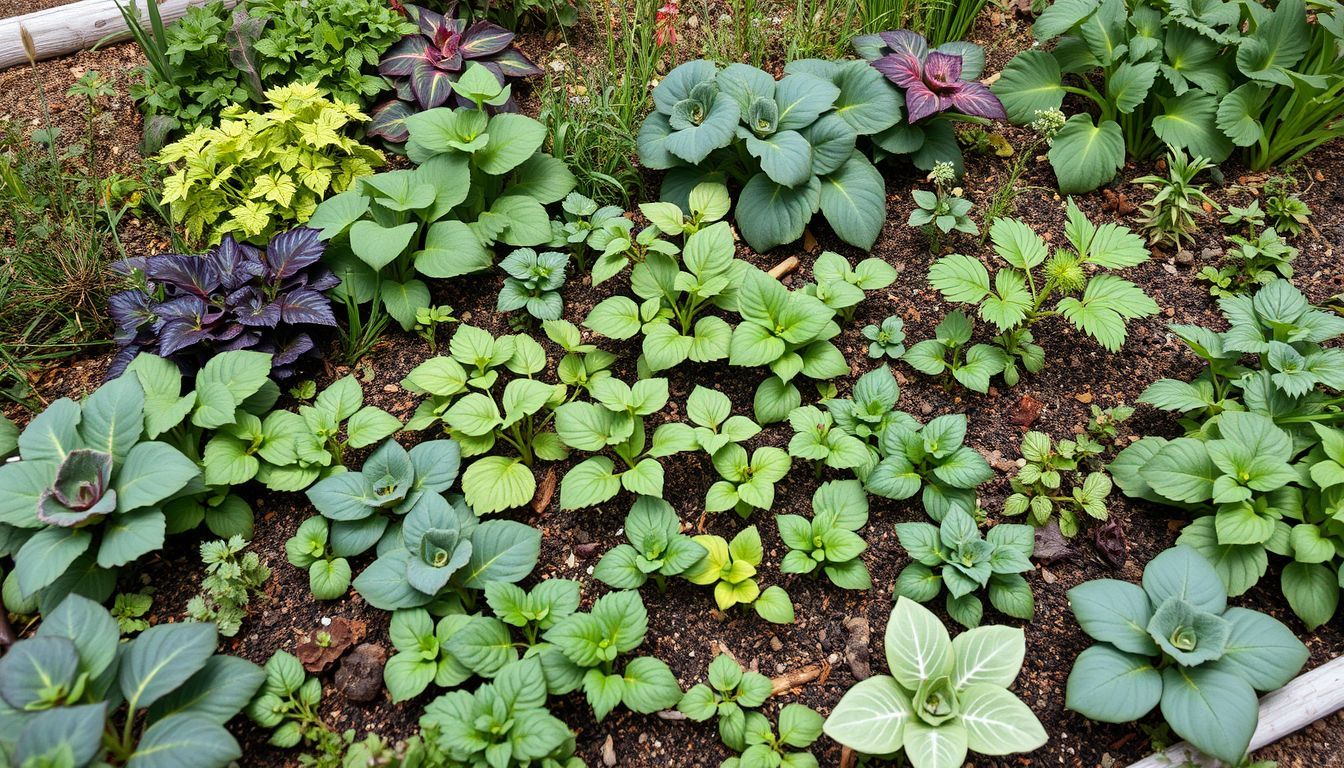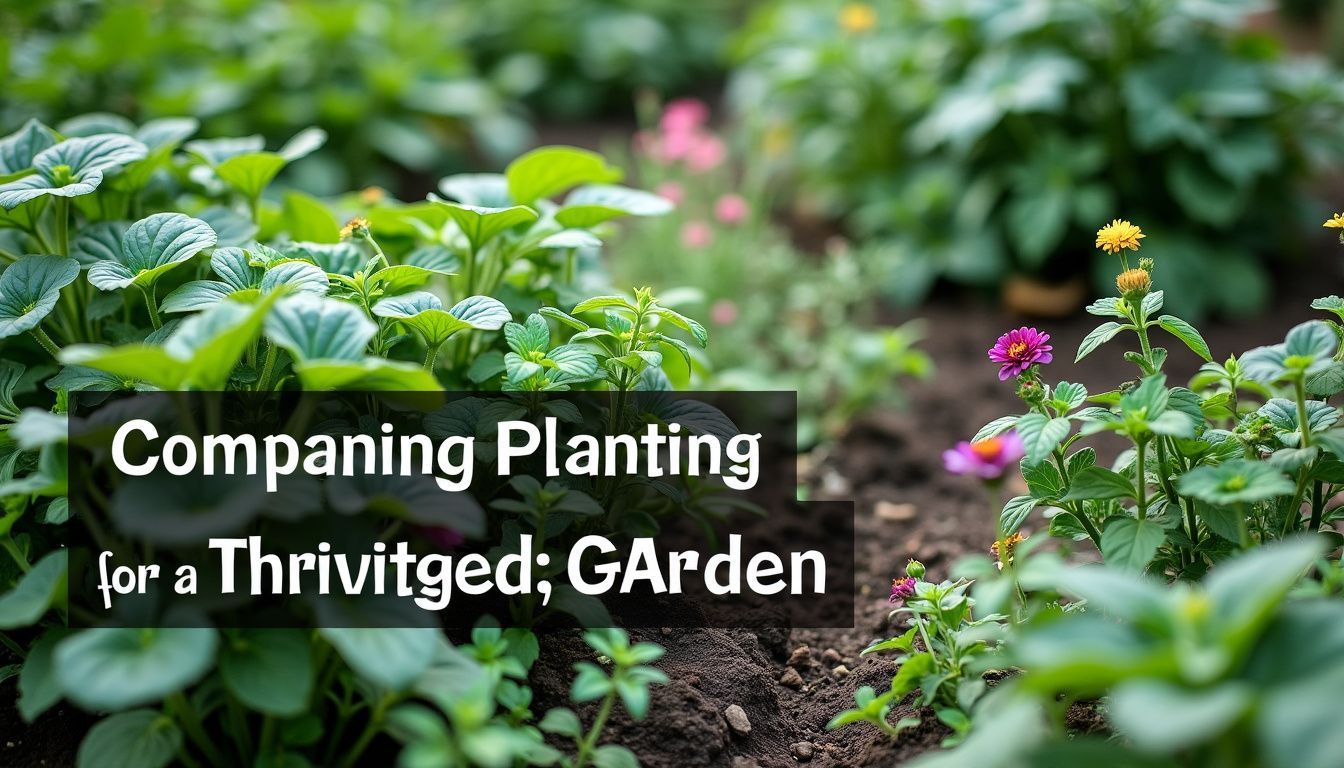Is your garden not doing as well as you hoped? Companion planting might be the answer. This method pairs plants together for happier, healthier gardens. Let’s get growing!
What is Companion Planting?

Companion planting is the strategy of placing certain plants together for mutual benefits. It taps into historical agricultural practices, originating from indigenous knowledge. This method involves various techniques like intercropping, crop rotation, and mixed planting to enhance growth, improve pest control, and boost overall garden health.
Through companion planting, gardeners mimic natural ecosystems, creating a symbiotic environment where plants support each other’s growth and resilience against pests.
The Benefits of Companion Planting
Companion planting accelerates plant growth, influences bug control, and augments crop production. It’s like providing your garden with an extraordinary ability without needing any sophisticated devices or chemicals.
View it as a cooperative effort where plants mutually benefit each other. For example, gardens that smartly match plants usually experience enhanced harvests compared to those adhering to one crop at a time.
This technique doesn’t solely thwart pests; it also contributes to the vitality of the soil. Diverse plants possess varied root structures, implying they can absorb more air and nutrients from the ground.
Furthermore, legumes have this unique trait where they extract nitrogen directly from the atmosphere and deposit it into the soil. So, you’re not strictly cultivating plants; you’re fostering healthier soil beneath them as well!
The Three Sisters Method
The Three Sisters Method features corn, beans, and squash. This ancient technique promotes mutual support among these plants. Corn grows tall and provides support for beans to climb.
Beans enrich the soil by fixing nitrogen. Squash spreads along the ground, blocking sunlight and reducing weeds.
Planting these three crops together creates a balanced ecosystem. Each plant plays a role, boosting the garden’s productivity. This method showcases agricultural symbiosis. It highlights the power of plant interdependence.
Traditional farming methods like this offer lessons for modern gardeners.
Partnering Vegetables for Mutual Support
Partnering vegetables can create a vibrant garden. For example, tomatoes enjoy basil. This duo flourishes together, as basil repels harmful pests. Carrots and onions also make a great combination.
The onion’s strong scent helps deter carrot flies.
Interplanting saves space and enhances growth. Pair lettuce, spinach, or basil with peppers or tomatoes. These combinations optimize your garden’s potential. Effective partners not only share nutrients but also safeguard each other from pests.
Using Flowers for Insect Management
Flowers play a significant role in managing insects in the garden. Marigolds, for instance, help reduce thrip populations in tomatoes. They attract beneficial insects that prey on pests.
Nasturtiums effectively deter squash bugs. African marigolds and sweet alyssum boost the population of natural aphid predators. Planting flowering plants can enhance both predator and parasitoid populations in your sweet corn.
These flowers work together to create a balanced ecosystem, keeping harmful insects at bay.
Incorporating Herbs for Added Benefits
Herbs play an important role in companion planting. Basil, for instance, effectively reduces thrip populations in tomatoes. This means healthier plants and better yields for gardeners.
Sage and thyme also excel by lowering diamondback moth populations. Planting these herbs in your garden can improve natural pest control. They act as insect repellents, creating a plant-based solution for common garden issues.
Incorporating herbs into your garden enhances plant defense mechanisms. They work hard to attract beneficial insects and repel pests. These plants can help you practice integrated pest management and promote sustainable agriculture.
Enjoy the benefits of home gardening while maximizing your garden’s potential.
Maximizing Space with Companion Planting
Maximizing space in your garden can make a big difference. Companion planting allows you to save space by mixing early, short-season crops with later-maturing varieties. For example, plant lettuce or spinach alongside peppers or tomatoes.
This method utilizes every inch of your garden effectively.
Intercropping provides more than just space-saving benefits. It promotes healthy growth and resilience among different plants. With smart planting arrangements, you can enjoy a thriving garden while making the most of your available area.
Space-efficient gardening is all about working with nature, not against it.
Attracting Beneficial Insects
Attracting beneficial insects can enhance your garden. Predatory insects like syrphid fly larvae feast on aphids, keeping your plants healthy. You can draw these helpful critters by creating visual diversity in your garden.
Mix different plants and flowers to create a vibrant atmosphere.
Choose flowers that bloom at various times. This approach provides a steady food source for beneficial wildlife throughout the growing season. With a bit of color and variety, you add beauty and invite these tiny allies to help you manage pests naturally.
Enhancing Soil Health with Companion Plants
Companion plants boost soil health in several ways. Different root structures improve soil aeration and nutrient extraction. This diversity allows roots to create channels, making it easier for water and air to reach deeper layers.
Legumes play a key role in this process. They fix atmospheric nitrogen, enriching the soil for other plants.
Using companion plants encourages plant symbiosis. Some plants release root exudates that feed beneficial microbes. These microbes enhance soil biodiversity, making your garden more resilient.
Intercropping and crop rotation also help maintain soil structure. Healthy soil leads to healthier plants, and that’s the goal of any gardener.
Tips for Successful Companion Planting
Start with vegetables your family enjoys. Each year, try growing one new vegetable. Sketch out your garden layout before planting. Use a Companion Gardening Chart for guidance. Keep notes on sun exposure and plant location.
Assess the structure suitability of your garden beds. Such planning helps with crop placement and enhances plant relationships. Pair compatible vegetables for better growth and production.
A well-thought-out gardening layout maximizes your space and yields. Use these tips for successful companion planting.
Starting Small and Experimenting
Starting small makes gardening less overwhelming. Begin with a few plants in one corner of your yard or even in pots. Trying out new things adds excitement to your gardening journey.
You might discover a plant that thrives or a combination that enhances growth. Sharing gardening experiences with friends can provide valuable tips and advice. Don’t hesitate to ask for gardening guidance from local experts or online communities.
Gardening experiments can teach you a lot. Observe how your plants interact with one another. Notice which pairings work best. Seasonal gardening allows for fresh starts. Each season offers a chance to test new ideas.
Planting in small projects gives you room to learn from mistakes. Take notes on what works and what doesn’t. Enjoy the process and celebrate your successes, no matter how small.
Companion Planting for Home Gardens
Companion planting works wonders in home gardens. It involves pairing plants that support each other. For example, using squash to deter squash bugs can save your harvest. Diverse plant combinations help create a balanced ecosystem.
Observing your garden allows you to see which plants thrive together.
Biodiversity attracts beneficial insects, which act as natural pest control. Mixing flowers with vegetables can further reduce pests. Experimenting with herbs can enhance flavors while also warding off unwanted visitors.
Each plant plays a role, making your garden lush and productive.
Seasonal Rotation and Planning
Rotate your crops each season. This method helps maintain soil health and prevents pests from becoming a problem. Keep detailed notes on your planting activities. Record what worked well and what didn’t.
Track your observations on crop enjoyment and plant performance. Adjust your partner pairings based on what you learn. A solid planting calendar can guide you through the year. Design your garden layout strategically for space efficiency.
Adjust your plans to match weather patterns. Embrace the joy of gardening while managing pests effectively.
Final Thoughts
Companion planting can enhance your garden into a flourishing ecosystem. Pairing plants wisely not only boosts growth but also combats pests. Make room for flowers and herbs alongside your vegetables.
Experimenting brings joy and surprises. Share your stories and tips in the comments below!






